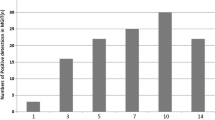Summary
The combination of the radiometric Bactec system and the Gen-Probe® forMycobacterium tuberculosis complex (MTB) in detection and identification of mycobacteria was evaluated. Löwenstein-Jensen and Coletsos media for isolation, and Bactec-NAP® test and cellular morphology and grouping for identification of MTB and mycobacteria other than tuberculosis (MOTT) were also evaluated. The study included all specimens submitted to our laboratory for mycobacteria detection over a 6-month-period. The mean recovery times of MTB were 13.7, 23.3, and 21.2 days for Bactec, Löwenstein-Jensen and Coletsos, respectively. Bactec system recovered 87.8% of MTB strains and 98% of MOTT, and the conventional media 82.9% of MTB and 19.2% of MOTT. Ziehl-Neelsen smears and Bactec-NAP® were effective in differentiating MTB and MOTT strains (3.3% and 9.6% respectively of the cultures were uninterpretable). Gen-Probe® (cutoff point for MTB = 5% of hybridisation) was applied to 100 positive vials of Bactec. All cultures of MTB with a growth index (GI) > 400 displayed hybridisation > 9% (average 28.9%) but for a GI<400, 17% of cultures showed < 5% of hybridisation (average 18.6%). All cultures for MOTT had < 5% hybridisation. With the combination Bactec/Gen-Probe the average time of the final report could be reduced to 15.5 days.
Zusammenfassung
Die Kombination aus radiometrischem Bactec System und Gen-Probe® fürMycobacterium tuberculosis-Komplex (MTB) wurde hinsichtlich ihrer Leistungsfähigkeit für den Nachweis und die Identifizierung von Mykobakterien geprüft. Parallel wurden Löwenstein-Jensen- und Coletsos-Medien für die Isolation und Bactec-NAP® Test, Zellmorphologie und Lagerung für die Identifizierung von MTB und anderen Mykobakterien (MOTT) beurteilt. In die Studie wurden alle Proben einbezogen, die im Zeitraum von sechs Monaten für den Nachweis von Mykobakterien in unser Labor eingesandt wurden. Für den Nachweis von MTB benötigte Bactec 13,7, Löwenstein-Jensen 23,3 und Coletsos Medium 21,2 Tage. Mit dem Bactec System wurden 87,8% der MTB-Stämme und 98% der MOTT-Stämme identifiziert, mit den konventionellen Medien 82,9% der MTB und 19,2% der MOTT-Stämme. Ziehl-Neelsen-Präparate und Bactec NAP® waren effektiv in der Differenzierung von MTB und MOTT (3,3% beziehungsweise 9,6% der Kulturen konnten nicht beurteilt werden). Gen-Probe® (Grenzwert für MTB = 5% Hybridisierung) wurde bei 100 mit Bactec positiven Proben eingesetzt. Bei allen Kulturen von MTB mit einem Wachstumsindex von mehr als 400 fand sich eine Hybridisierung von mehr als 9% (im Durchschnitt 28,9%). Bei einem Wachstumsindex von weniger als 400 wiesen 17% der Kulturen weniger als 5% Hybridisierung auf (Durchschnitt 18,6%). Alle Kulturen, die MOTT enthielten, hatten eine Hybridisierung von weniger als 5% gezeigt. Mit der Kombination Bactec/Gen-Probe konnte die mittlere Zeit bis zum Abschlußbericht auf 15,5 Tage reduziert werden.
Similar content being viewed by others
References
Vidal Pla, R., Ruiz Manzano, J. Aumenta la tuberculosis en España? Med. Clin. (Barc.) 86 (1986) 845–847.
Grzybowski, S. Tuberculosis control. The end of an era? Chest. 84 (1983) 123–125.
de March Ayuela, P. El declive de la infección tuberculosa en España. Rev. Clín. Esp. 176 (1985) 482–483.
Centers for Disease Control Tuberculosis, final data. United States, 1986. MMWR 36 (1988) 817–820.
de March Ayuela, P. Tuberculosis y SIDA. Situación en España. Perspectivas. Rev. Clin. Esp. 186 (1990) 365–368.
Capewell, S., Leitch, A. G. The value of contact procedures for tuberculosis in Edinburgh. Br. J. Dis. Chest. 78 (1984) 317–329.
Vestal, A. L. Procedures for the isolation and identification of mycobacteria. U.S. Department of Health, Education and Welfare. Publication no. (CDC) 77-8230. Center for Disease Control, Atlanta, USA, 1975.
Roberts, G. D. Mycobacteria and nocardia. In:Washington, J. A. (ed.): Laboratory procedures in clinical microbiology. 2nd ed. Springer-Verlag, New York 1985, pp. 379–418.
Youmans, G. P. The morphology and metabolism of mycobacteria. In:Youmans, G. P. (ed.): Tuberculosis. W. B. Saunders, Philadelphia 1979, pp. 8–45.
Moreu Aboal, E., Molinero Casares, L. M., Fernández Peris, E. SIGMA. Madrid: Horus Hardware, 1989.
Anargyros, P., Astill, D. S. J., Lim, I. S. L. Comparison of improved BACTEC and Löwenstein-Jensen media for culture of mycobacteria from clinical specimens. J. Clin. Microbiol. 28 (1990) 1288–1291.
Morgan, M. A., Horstmeier, C. D., DeYoung, D. R., Roberts, G. D. Comparison of radiometric method (BACTEC) and conventional culture media for recovery of mycobacteria from smear-negative specimens. J. Clin. Microbiol. 18 (1983) 384–388.
Robers, G. D., Goodman, N. L., Heifets, L., Larsh, H. W., Lindner, T. H., McClatchy, J. K., McGinnis, M. R., Siddiqi, S. H., Wright, P. Evaluation of the BACTEC radiometric method for recovery of mycobacteria and drug susceptibility testing ofMycobacterium tuberculosis from acid-fast smear-positive specimens. J. Clin. Microbiol. 18 (1983) 689–696.
Yagupsky, P. V., Kaminski, D. A., Palmer, K. M., Nolte, F. S. Cord formation in Bactec 7H12 medium for rapid, presumptive identification ofMycobacterium tuberculosis complex. J. Clin. Microbiol. 28 (1990) 1451–1453.
Lazlo, A., Siddiqi, S. H. Evaluation of a rapid radiometric differentiation test for theMycobacterium tuberculosis complex by selective inhibition with p-nitro-α-acetylamino-β-hydroxypropiophenone. J. Clin. Microbiol. 19 (1984) 694–698.
Gross, W. M., Hawkins, J. E. Radiometric selective inhibition test for differentiation ofMycobacterium tuberculoosis, Mycobacterium bovis, and other mycobacteria. J. Clin. Microbiol. 21 (1985) 565–568.
Sherman, I., Harrington, N., Rothrock, A., George, H. Use of a cutoff range in identifying mycobacteria by Gen-Probe rapid diagnostic system. J. Clin. Microbiol. 27 (1989) 241–244.
Peterson, E. M., Lu, R., Floyd, C., Nakasone, A., Friedly, G., de la Maza, L. M. Direct identification ofMycobacterium tuberculosis, Mycobacterium avium, andMycobacterium intracellulare from amplified primary cultures in BACTEC media using DNA probes. J. Clin. Microbiol. 27 (1989) 1543–1547.
Body, B. A., Warren, N. G., Spicer, A., Henderson, D., Chery, M. Use of Gen-Probe and Bactec for rapid isolation and identification of mycobacteria. Correlation of probe results with growth index. Am. J. Clin. Pathol. 93 (1990) 415–420.
Author information
Authors and Affiliations
Rights and permissions
About this article
Cite this article
Telenti, M., Alvarez, M., Santos Rionda, M.J. et al. The diagnostic usefulness of a DNA probe forMycobacterium tuberculosis complex (Gen-Probe®) in Bactec cultures versus other diagnostic methods. Infection 22, 18–23 (1994). https://doi.org/10.1007/BF01780758
Received:
Accepted:
Issue Date:
DOI: https://doi.org/10.1007/BF01780758




